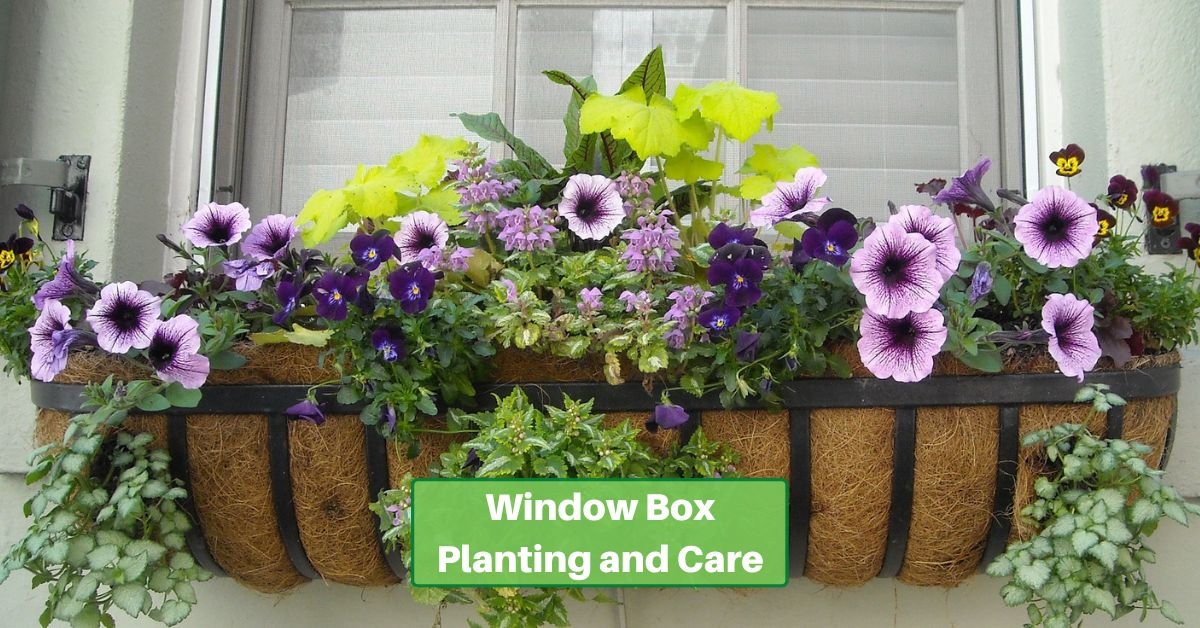Window box gardening is a delightful way to add a splash of color and nature to your home, regardless of size. These mini gardens offer a unique opportunity to showcase creativity and connect with nature, even in urban settings. Of course, understanding the specific needs of window box planting is critical to cultivating a flourishing and vibrant display that enhances your living space. So, let’s talk about some of the most important considerations!
Selecting the Right Window
Before you begin, consider the best location for your window box. Visibility and accessibility are essential for both enjoyment and maintenance. You want to be able to see and enjoy the window box. You’ll also need to reach it for watering and care easily.
Also, pay attention to the sunlight and shade patterns throughout the day. These are crucial in selecting the right plants that thrive in your conditions.
Selecting the Right Window Box
When it comes time to choose your window box, you’ll have various options. Here are some things to take into account:
Materials for Window Boxes
Window boxes come in various materials. The look is one factor in choosing, but you should also consider durability, size, and weight.
Wood: Aesthetically pleasing but requires regular maintenance against rot and weather damage.
Plastic: Lightweight and cost-effective, but may not withstand harsh weather for long.
Metal: Durable and stylish, though they can heat up in direct sunlight, affecting root temperature.
Ceramic: Beautiful but heavy and fragile, best for stable, sheltered locations.
Size and Depth
A window box’s width usually matches your window, but you’ll still have to consider the depth. Consider the root needs of your chosen plants. A deeper box allows for more extensive root systems, essential for the health and growth of larger plants.
Drainage
Proper drainage is also crucial. Ensure your window box has adequate drainage holes to avoid waterlogging. This will help evade root rot and other issues.
Choosing Suitable Plants
Of course, you’ll want to choose plants that will thrive in your window box. These guidelines can help:
Plant Varieties
Select plants well-suited for your climate and the light conditions at your window. A few options include:
- Flowers: Petunias, geraniums, and pansies for color.
- Herbs: Basil, thyme, and mint for utility and fragrance.
- Small Vegetables: Lettuce, radishes, and strawberries for fresh produce.
Color and Design
Create visually appealing arrangements by considering color combinations and bloom times. Think about height and texture for a dynamic display.
Soil and Planting Techniques
Once you’ve made these choices, you’ll have to start filling your window box with soil and plants!
Use a high-quality potting mix designed for containers like a window box. It should be well-draining yet able to retain enough moisture for healthy growth.
When you plant, avoid overcrowding. This ensures adequate air circulation and reduces the risk of disease. Arrange plants of varying heights and textures for depth and interest. Taller plants can form a backdrop, with shorter and cascading varieties in the front.
Maintenance and Care
Now that your plants are in their new home, you have to pay careful attention to their needs.
Watering
Remember that a window box’s small amount of soil dries out more quickly than the ground.
Techniques: Water your window box thoroughly until excess water drains out. Avoid wetting the foliage to reduce the risk of disease.
Frequency: How often you water depends on the weather and type of plants. Daily watering might be necessary in hot weather, while in cooler weather, less frequent watering is required.
Fertilizing
Use a balanced, water-soluble fertilizer every two to four weeks. As with water, plants will use the nutrients in their limited space more quickly than if they were in the ground.
Regular fertilizing during the growing season supports lush growth and vibrant blooms.
Pruning and Deadheading
Regularly remove dead or fading flowers (deadheading) and prune back overgrown plants. This encourages new growth and maintains the aesthetic appeal of your window box.
Seasonal Considerations
As with all plants, your window box foliage will have changing needs throughout the year.
In summer, you may have to protect plants from extreme heat and sun exposure by ensuring adequate water and possibly shading during the hottest part of the day.
Once winter rolls around, consider moving the window box indoors or wrapping it for insulation if your plants are sensitive to the cold. Some plants may need to be replaced with cold-hardy varieties.
Transitioning Plants
As seasons change, switch out plants. Spring bulbs, summer annuals, autumn mums, and evergreens for winter can provide year-round interest. Many can be moved indoors after their time in the window, and others will enjoy a home in the garden.
Troubleshooting Common Problems with Window Boxes
No gardening is without potential issues, and it’s essential to be attentive to the ones in your window box. Its small size can make some issues easy to manage but can also complicate other problems.
Pests and Diseases
Inspect your plants often for signs of pests or disease, such as discolored leaves or unusual markings. Use appropriate organic or chemical treatments as needed, following safety guidelines.
Over/Under Watering
Wilting or yellowing leaves can indicate watering issues. Adjust your watering schedule according to the needs of your plants and the weather conditions.
Weather Damage
When severe weather is forecast, use covers or move boxes to sheltered areas. If any parts are damaged, trim them and provide appropriate care to help the plants recover.
Creative Ideas and Inspiration
A window box is a small canvas, but you still have ample room for imagination!
Themed Window Boxes
Here are just two ideas that go beyond colors and heights:
Culinary Herbs: Create a kitchen garden with herbs like rosemary, parsley, and cilantro. It looks great, and you can use them in your cooking!
Pollinator Attractors: Plant flowers like lavender and marigold to attract bees and butterflies. You will enjoy the beauty of not only flowers but also of these beautiful creatures!
DIY Decorations
You can also add personal touches with decorations like painted wooden labels, decorative stones, or small figurines.
Let your ideas run wild, and see how you can create a beautiful scene outside your window!
Window box gardening is a rewarding hobby that brings beauty and nature to your living space. It’s a canvas for creativity, a source of fresh herbs or flowers, and a small yet significant contribution to home beauty. Experiment with different plants and designs, and most importantly, enjoy nurturing and watching your miniature garden thrive!









